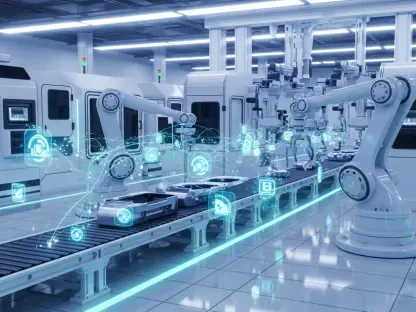In an era where digital infrastructure underpins nearly every facet of modern industry, the recent cyber attack on Jaguar Land Rover (JLR), a prominent British car manufacturer under Tata ownership, has sent shockwaves through the automotive sector, exposing vulnerabilities in corporate cybersecurity. This unprecedented breach, which crippled operations and threatened the livelihoods of thousands, has not only highlighted the fragility of interconnected systems but also prompted swift intervention from the UK government to avert a broader economic crisis. The incident underscores a growing trend of sophisticated cyber threats targeting high-profile companies, particularly those with complex supply chains and heavy reliance on digital systems. As details of the attack continue to emerge, the focus has shifted to the scale of the disruption, the financial toll on JLR and its partners, and the measures being taken to safeguard against future breaches. This event serves as a stark reminder of the challenges posed by organized cybercrime in today’s digital landscape.
Unveiling the Scale of Disruption
The cyber attack on JLR, first reported earlier this month, brought the company’s operations to a grinding halt, revealing the profound impact of digital vulnerabilities in the automotive industry. On the initial day of the breach, dealers found themselves unable to register new vehicles during a critical sales period, causing immediate frustration and financial loss. Within 24 hours, JLR was forced to shut down its global systems, effectively stopping car production across all facilities. The estimated revenue loss stands at a staggering £50 million per week, a figure that highlights the severity of the operational paralysis. Beyond the company itself, the ripple effects have touched an extensive network of suppliers, with around 150,000 employees across 700 British firms facing uncertainty due to disrupted workflows. This incident illustrates how a single cyber event can cascade through an entire industry, affecting not just one entity but countless interconnected stakeholders who depend on seamless operations for their survival.
Compounding the operational challenges, the financial repercussions of the cyber attack have placed immense pressure on JLR’s balance sheet and future planning. While production lines remain idle, the costs of system recovery, cybersecurity enhancements, and lost sales continue to mount, creating a daunting path to recovery. The broader economic implications are equally concerning, as regions like the West Midlands and Merseyside, which rely heavily on JLR for skilled jobs, brace for potential long-term impacts. The company has engaged law enforcement and cybersecurity experts to investigate the breach and restore systems safely, though the timeline for full recovery remains unclear. Meanwhile, the lack of transparency regarding the specifics of the compromised data has fueled speculation about the potential exposure of sensitive customer information. This uncertainty adds another layer of complexity, as trust—both from consumers and business partners—becomes a critical factor in navigating the aftermath of such a disruptive event.
Government Intervention and Economic Safeguards
In response to the crisis engulfing JLR, the UK government has stepped in with a substantial financial package aimed at stabilizing the company and protecting the wider economy. A £1.5 billion loan guarantee, underwritten through the Export Development Guarantee (EDG) and repayable over the next five years, has been announced to provide immediate relief. This decisive action reflects a recognition of the automotive sector’s vital role in sustaining jobs and industrial output across key regions. Business Secretary Peter Kyle and Chancellor Rachel Reeves have emphasized that the support is designed to safeguard skilled employment and bolster the fragile supply chain, which has been severely strained by the attack. Such intervention highlights a broader policy commitment to shielding critical industries from the fallout of cyber threats, ensuring that temporary setbacks do not translate into permanent economic damage for communities reliant on JLR’s operations.
Beyond the immediate financial lifeline, the government’s involvement signals a proactive stance on addressing the growing menace of cybercrime against major corporations. The scale of the loan guarantee underscores the urgency of maintaining industrial stability in the face of digital disruptions that can have far-reaching consequences. While the support package offers a buffer for JLR to regroup, it also raises questions about the long-term strategies needed to prevent such incidents. The government’s role extends beyond funding, as collaboration with industry leaders and cybersecurity specialists becomes essential to fortify defenses across sectors. For JLR, this backing provides a critical window to rebuild systems and restore confidence among stakeholders, though the road ahead will require sustained efforts to address vulnerabilities. As the automotive industry watches closely, this intervention may set a precedent for how governments respond to cyber crises that threaten national economic interests.
Cyber Threat Landscape and Hacker Involvement
Delving into the specifics of the cyber attack, JLR has acknowledged that some data was compromised, though the exact nature and extent remain under wraps, fueling concern among affected parties. The company has committed to notifying individuals impacted by the breach, while police and cybersecurity teams work to trace the source and secure systems for a safe restart. Although not officially confirmed, the involvement of law enforcement suggests that customer or sensitive operational data may have been exposed, a possibility that could erode trust if mishandled. On the third day following the initial report, a hacker group known as Scattered Lapsus$ Hunters claimed responsibility, adding a chilling dimension to the incident. This group, previously linked to a disruptive attack on a major retailer, has a track record of targeting high-profile entities, indicating a pattern of sophisticated and organized cybercrime that poses a persistent threat to industries worldwide.
The emergence of Scattered Lapsus$ Hunters as the alleged perpetrators sheds light on the evolving landscape of cyber threats facing modern corporations, particularly those in digitally dependent sectors like automotive manufacturing. Their involvement points to a calculated strategy of exploiting vulnerabilities in large organizations, often for financial gain or to cause maximum disruption. For JLR, the challenge lies not only in recovering from this specific attack but also in fortifying defenses against future incursions by such groups. The broader industry must take note, as the increasing frequency and sophistication of these threats demand robust cybersecurity frameworks and rapid response mechanisms. As investigations continue, the focus remains on understanding how the breach occurred and what measures can prevent a recurrence, with the hope that lessons learned will strengthen resilience across the board in an era where digital security is as critical as physical safety.
Reflections on a Path Forward
Looking back, the cyber attack on JLR marked a pivotal moment that exposed the fragility of digital systems in the face of determined adversaries. The operational shutdown, coupled with staggering financial losses, painted a grim picture of the immediate aftermath, while the involvement of a notorious hacker group underscored the organized nature of the threat. Government intervention through a substantial loan guarantee provided a lifeline, reflecting a commitment to preserving economic stability and protecting jobs. As JLR worked to restore systems and rebuild trust, the incident served as a wake-up call for the automotive industry to prioritize cybersecurity with the same urgency as innovation. Moving forward, a collaborative approach involving corporations, policymakers, and security experts will be essential to develop stronger defenses and response strategies. Only through such unified efforts can the sector hope to mitigate the risks of future attacks and ensure that digital progress does not come at the cost of vulnerability.









